Clancy Tucker's Blog, page 116
May 19, 2019
20 May 2019 - ANCIENT FEMALE BELT BUCKLES FOUND IN RUSSIA
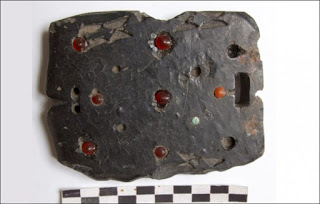
ANCIENT FEMALE BELT BUCKLES FOUND IN RUSSIA
G'day folks,
I'm always on the lookout for ancient discoveries. Check out these ancient belt buckles. Only 10 examples of these type of accessories are known in the world.
In a remote part of Russia, near the border with Mongolia, an archaeological investigation has been excavating the graves of Xiongnu people, a nomadic group who lived in what’s now the Tuva Republic from about the 3rd century B.C. to the 1st century A.D. Some of the most striking finds have been in the graves of Xiongnu women, who were buried with fantastic belt buckles made of coal, jewels, and bronze, The Siberian Times reports.
 The belt buckles are decorated with depictions of animals from fictional dragons to panthers, yaks, camels, and snakes.
The belt buckles are decorated with depictions of animals from fictional dragons to panthers, yaks, camels, and snakes.
The coal buckles in particular are very rare. Marina Kilunovskaya, the archaeologist leading the project for the of theRussian Academy of Sciences’ Institute for the History of Material Culture, told The Siberian Times that there are only 10 known examples of these types of belt buckles. Kilunovskaya worked with the archaeologist Pavel Leus, a specialist of the Xiongnu period.
Xiongnu is a Chinese term from that period for nomadic, invading groups seen as a threat to China. In the period that these burials date to, a coalition of nomadic tribes from Central Asia were encroaching on Chinese territory.
Chinese sources note that Xiongnu women fought alongside men, and the archaeological evidence backs that up. As Foreign Affairs reports, in at least 300 burials found across Asia, the remains of women show signs that they fought in battle. At least a quarter of the women found buried with weapons were active warriors. Both men and women wore elaborate belt buckles, decorated with animals both imaginary and real.

Excavations at this site, supported by The Society for the Exploration of Eurasia, began in 2015 and are still ongoing. The same area has many burials from the Scythian era, starting in the 2nd century B.C., through the Middle Ages.
 Clancy's comment: Extraordinary, but beautiful eh? I bet those female warriors could pack a mean punch.I'm ...
Clancy's comment: Extraordinary, but beautiful eh? I bet those female warriors could pack a mean punch.I'm ...

Published on May 19, 2019 17:53
May 18, 2019
19 May 2019 - STUNNING CAVES AROUND THE WORLD
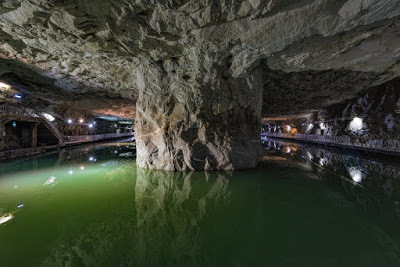
STUNNING CAVES AROUND THE WORLD
G'day folks,
I'm not sure about you but I hate confined spaces, even when having medical tests like Pet and Cat scans. However, others seem to love these spaces. The recent rescue of the Thai soccer boys left me gob smacked. Anyway, check out these hidden spaces from around the world. Many have revealed hidden secrets of life in the past.


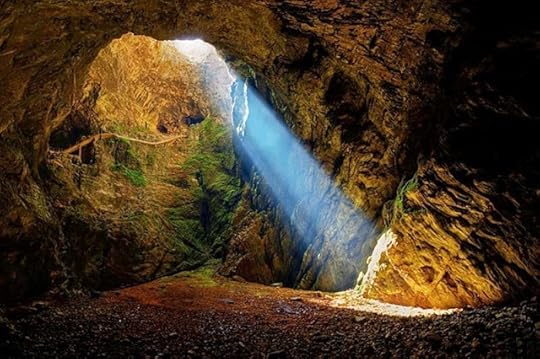
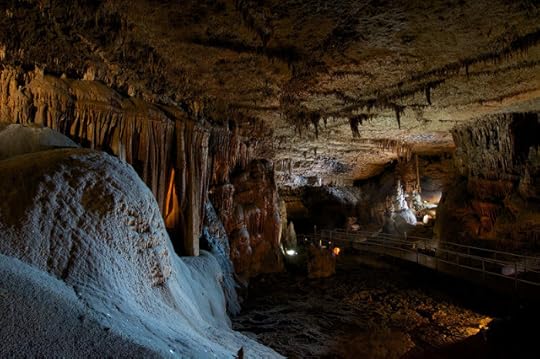











Clancy's comment: Mm ... Not for me, unless I can see daylight. What about you?
I'm ...


Published on May 18, 2019 17:11
May 17, 2019
18 May 2019 - HEART-STOPPING PHOTOGRAPHS ... BEING THERE AT THE RIGHT TIME.

HEART-STOPPING PHOTOGRAPHS ... BEING THERE AT THE RIGHT TIME
G'day folks,
You know I'm a photographer as well as an author, and you have probably heard me say this before ... You have to be there at the right time, and press the button. Now, check out these shots.




















Clancy's comment: Brilliant shots, eh?
I'm ...


Published on May 17, 2019 19:32
May 16, 2019
17 May 2019 - A BUNCH OF INSPIRING QUOTES

A BUNCH OF INSPIRING QUOTES
G'day folks,
Welcome to some great quotes worth passing on.












Clancy's comment: As usual, pass them on to those who might benefit.
I'm ....


Published on May 16, 2019 19:41
May 15, 2019
16 May 2019 - ICE AGE CAVE FOUND BENEATH MONTREAL
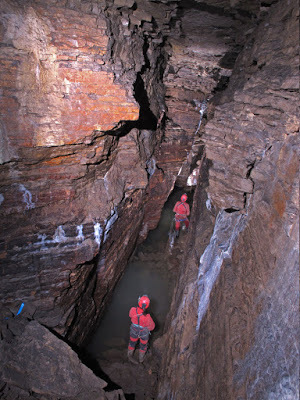
ICE AGE CAVE FOUND BENEATH MONTREAL
G'day folks,
Saint-Leonard, known as Saint-Leo, a district in eastern Montreal, boasts some of the best Italian cuisine in town—many of the nearly 92,000 Italians who moved to Quebec after World War II settled there and opened cafes, bakeries, and a long-standing flight over language (since the Italian migrants preferred English to French). It looks like the neighborhood’s vibrant street life may be matched by its underground world.
Local speleologists and cave enthusiasts were already familiar Saint-Leonard Cave, a 115-foot-wide cavern discovered in 1812 beneath what is now Pie XII Park. And now they will have more to explore, as the cave network was recently discovered to be vastly larger than once thought.
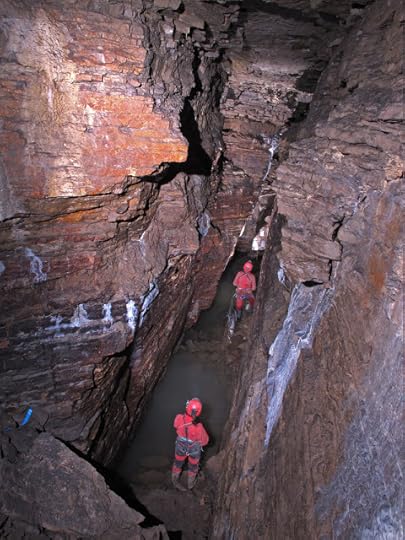
“Two years ago we were making some tests outside one of the cave walls and found a crack,” says François Gélinas, of the Quebec Speleology Society. “We used an endoscopic camera, which showed that beneath the crack lay a room.” He explains that they were unable to break through the limestone around the crack. But then last month society members identified a softer spot, and were able to open a passage. “After three hours of drilling we were able to open a hole,” he says. “We looked inside and saw that it was a much longer cave system that what we originally thought .... It is an incredibly long network that stretches for at least 600 feet right under the city.”
Experts believe that the cave system took shape during the last Ice Age, when receding glaciers left fissures in the bedrock. Glacial meltwater helped further carve out the cave, which has many delicate stalactites dangling from its 20-foot-high ceiling—rare for a cave so far north. “Stalactites form when water dissolves limestone by virtue of its acidic components, but cold water is less acidic so it takes more time for formation to take place, like half an inch by a thousand years or so—so it is very rare to find them here,” Gélinas says.

After leading the local press on a cave tour, which included crawling on hands and knees through narrow, muddy passages, the team is now waiting for the dry season, when the groundwater retreats, so they can continue exploring. “We want to find out just how far the cave system reaches but right now we can only go in with scuba diving equipment,” he says. “When the cave water will retreat—around February—it will be easier for us to venture further in.”

Clancy's comment: Interesting, but I'm glad it's them crawling through those narrow spaces.
I'm ...


Published on May 15, 2019 19:03
May 14, 2019
15 May 2019 - 19th CENTURY FORT BENEATH ALCATRAZ

19th CENTURY FORT BENEATH ALCATRAZ
G'day folks,
Before Capone took up residence, the island was home to military installation that guarded San Francisco Bay.
lcatraz Island in San Francisco Bay has a long history as a military and federal prison. But before the Rock became the Rock, the site was home to Fort Alcatraz, a military installation commissioned to protect the then-burgeoning city of San Francisco. That fort, and most signs of it, are long gone. But as Katie Dowd at SFGate.com reports, archaeologists recently located hidden structures below the concrete prison that show a glimpse of what was.
Because of its historical importance—Alcatraz Island is part of the Golden Gate National Recreation Area and administered by the National Park Service—archaeologists couldn’t just dig up the mostly cement prison yard to see what was under it. Instead, researchers used non-invasive ground-penetrating radar and laser scans to locate to see if they could find anything still lying beneath. Afterward, they compared their results to old maps, historical documents and photographs to help them interpret their data. All together, they believe they’ve located an ammunition magazine, a “bombproof” earthwork traverse as well as brick and masonry tunnels. The finds are revealed in the journal Near Surface Geophysics.

“This really changes the picture of things,” lead author Timothy de Smet, an archaeologist at Binghamton University, tells Katherine J. Wu at Nova. “These remains are so well preserved, and so close to the surface. They weren’t erased from the island—they’re right beneath your feet.”
There’s a reason the fort at Alcatraz didn’t last. Adam Brinklow at Curbed San Francisco reports that construction of a brick and masonry fort on the island began in 1853, but even before it was completed, powerful new artillery made that style of construction obsolete. In 1870, the military began a project to upgrade the island to sturdier earthwork fortifications, but that plan was not completed. Instead, during the Civil War and late 1800s, the military began using Alcatraz as a prison and quarantine zone for soldiers with tropical diseases. Its reputation as a prison fort grew from there, and in 1907, the U.S. officially designated it a military prison.
The military went about constructing the massive concrete cellblock it’s become known for—the world’s largest reinforced concrete building at the time of its completion in 1912—burying the remains of the old fort and earthworks beneath.

Maintaining the island prison was a costly endeavor, not to mention Alcatraz’s harsh conditions were bad PR. In 1933, the military transferred the prison to the U.S. Bureau of Prisons where for the next 30 years it served as a segregation unit for the most difficult prisoners housed in federal custody. That’s the era that made the Rock legendary in popular culture. Due to the expenses of running it, it closed its doors for good in 1963.

The new archaeological research shines a light on the long-lost history of the island before Al Capone, Machine Gun Kelly and the “Birdman” Robert Stroud made it infamous. “This really reinforces what several historians and archaeologists had long suspected,” co-author and Alcatraz historian John Martini tells Wu. “Up until this point, we had nothing to go on except for a few visible trace remains and maps—and a lot of suspicion.”
In the article, the researchers suggest this type of non-invasive research can help archaeologists investigate other sensitive places, too, so as they put it they can “figuratively rather than literally dig up an otherwise inaccessible but fascinating past.”

Clancy's comment: Mm ... there ya go.
I'm ...


Published on May 14, 2019 20:27
May 13, 2019
14 May 2019 - WORLD’S BIGGEST OUTHOUSE RACE IN ALASKA

WORLD’S BIGGEST OUTHOUSE RACE IN ALASKA
G'day folks,
Now, this will probably make you smile. An outhouse, also known by many other names, is a small structure, separate from a main building, which covers a toilet. This is typically either a pit latrine or a bucket toilet, but other forms of dry toilets may be encountered. The term may also be used to denote the toilet itself, not just the structure itself. Here, we call them a Dunny.
Dozens of teams compete in this annual event in Anchorage, all trying their best to not be number two.

It’s often said that second place is the first loser, but at the Outhouse Races in Anchorage, Alaska, no one wants to be number two.
Since 2006, teams have descended upon downtown Anchorage to compete in the annual race hosted by the University of Alaska Anchorage's Architecture and Engineering Club. Although similar races exist around the world, this one is considered the world's largest and was started by the school as a fundraiser for Habitat for Humanity. (Each team pays $100 to compete.) The event is part of Fur Rondy, the city’s two-week winter festival. But while vying to win may be the ultimate goal (top competitors receive trophy-turned-toilet-paper holders, not to mention bragging rights), it’s reaching the starting line that often proves to be the most challenging aspect of the event.

To even compete in the race, which took place on February 23 this year, teams of ten must first construct their outhouses and have them inspected by a race committee to ensure that each one is structurally sound for competition.Bob Maxwell, the AE Club’s faculty advisor and an adjunct professor in UAA’s Facilities, Planning and Construction department (he’s also the event’s emcee), was tasked with giving the inspected outhouses the final green light. Although building an outhouse might seem like a relatively straightforward task, designing one that’s mobile and mounted to a pair of skis or a snowboard adds an unusual twist to the competition.

Outhouses can be built using any number of materials. Plywood and metal have proven to be popular choices over the years, however teams have also fashioned shopping carts and water tanks into roving restrooms. Besides skis or a snowboard, teams of five (with one person riding inside the outhouse) can use a rope to pull or push bars to thrust their outhouses simultaneously to the finish line.
“We also require that each outhouse be equipped with a roll of toilet paper,” Maxwell says. “And, of course, reading material.”
Racing teams can compete in one of two categories: traditional and unlimited. To comply with "traditional" specifications, the outhouse must have, at minimum, a 30-inch-by-30-inch base and three walls, whereas "unlimited" outhouses can be as large as 8-feet wide, 12-feet long and 8-feet tall. During the race, there must be four pushers or pullers and one helmeted rider. This year more than a dozen teams competed. While many of the teams are made up of university students, members of the community also compete, including students from local middle schools and high schools.
"We once had a team from Seattle come up two years in a row to race," Maxwell says.


And because the race is organized by the AE Club, teams put much care into designing outhouses that are not only easy to maneuver, but also able to stay intact during the competition’s multiple heats, which are organized in a bracket system similar to those used during athletic tournaments like March Madness.

Clancy's comment: Looks like heaps of fun, eh?
I'm ...


Published on May 13, 2019 18:43
May 12, 2019
13 May 2019 - Neanderthal Circles of Stones Discovered – Constructed 176,500 Years Ago
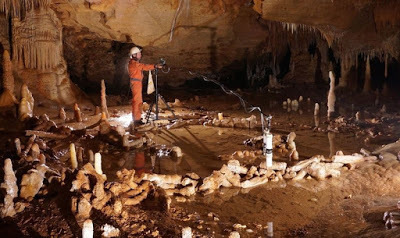
Neanderthal Circles of Stones Discovered – Constructed 176,500 Years Ago
G'day folks,
Well, here is another startling discovery from the past. In a cave in France, two circles of carefully cut and arranged stalagmites have been discovered.
Approximately 176,500 years ago, in a cave in what is now called France, Neanderthals cut 400 pieces of stalagmite into regular lengths and arranged them in two circles and four piles. In 1990, a teenager and a group of local cavers rediscovered them. Only now, though, have scientists estimated just how old they are—dating well beyond the history of Homo sapiens in this area.
This is one of the earliest examples of construction ever found, and the first example of Neanderthal construction that scientists have dated. It shows that these early homonins explored underground and could use fire and reveals an unknown aspect of their culture. It’s not clear what the circle of stones was used for, but it’s possible it had a ritual function, since there’s no evidence that anyone actually lived in the cave.
The cave, in Bruniquel, France, a small town in the country’s mountainous southwest, was sealed for many years by a rockslide. In 1990, a 15-year-old boy cleared those rocks enough for cavers to slip inside, where they found evidence that bears had once lived there, along with the circles.

One circle is larger than the other. The smaller is about 6.5 feet in diameter; the larger is more oval-shaped, and its diameter ranges from about 13 to 23 feet. The stalagmite pieces used to form these structures are made from the middle of stalagmite pieces and include neither the tip nor root of the stones. They are standardized in size, with one set averaging about 11.6 inches and the other about 13.5 inches. Some of the stones set in the circles have others propping them up. Two of the four piles of stones are inside the larger circle.
In this area, there are also bones and evidence of fire. One of these bones, a bear bone, was dated closer to when the cave was first discovered and found, with carbon dating, to be about 47,500 years old. But, as the Atlanticexplains, carbon dating only works for objects younger than 50,000 years old. When Sophie Verheyden, a scientist specializing in stalagmites, heard about the cave, she wondered if it was possible that the structures might be much older, given the limits of carbon dating. In this new study, published in Nature,she and colleagues dated the stalagmites using uranium levels to get to the much older age of the structure.
Recent discoveries have recalibrated humans’ understanding of Neanderthals, long portrayed as less intelligent and inferior hominins than us very special hominins. But it’s becoming clear that they had a lot going on as well—they made art, used tools, buried their dead, and interbred with humans. This new finding shows that long before Homo sapiens had ever reached Europe, they were hanging out in caves, burning things, and making rock circles. Sounds like a pretty good time.

Clancy's comment: Amazing, eh? What will they find next?
I'm ...


Published on May 12, 2019 18:34
May 11, 2019
12 May 2019 - SOME GREAT SNAPS FROM YESTERYEAR

SOME GREAT SNAPS FROM YESTERYEAR
G'day folks,
Welcome to some great photographs from yesteryear. Some of you may recognise some of the folks depicted.









 Clancy's comment: Loved them. What was your favourite?I'm ...
Clancy's comment: Loved them. What was your favourite?I'm ...


Published on May 11, 2019 18:41
May 10, 2019
11 May 2019 - MAGICAL FREE LIBRARY BUILT INTO DEAD TREE

MAGICAL FREE LIBRARY BUILT INTO DEAD TREE
G'day folks,A rotting 110-year-old black cottonwood tree has received a second life. In the city of Coeur d’Alene, Idaho, known to many as a sleepy lakefront resort town, a woman named Sharalee Armitage Howard has turned a dying 110-year-old black cottonwood tree into a magical library.

Stone steps lead up the sloped front yard to what remains of the tree. The 10-foot-tall trunk has a shingled roof that extends a little over the edges. A lantern-style lamp lights a row of tiny faux wooden books that make up the library’s decorative dentil molding. The real books, however, are visible through a vintage window-turned-door. The door itself features hardware that looks like it would have been at home in Middle Earth.
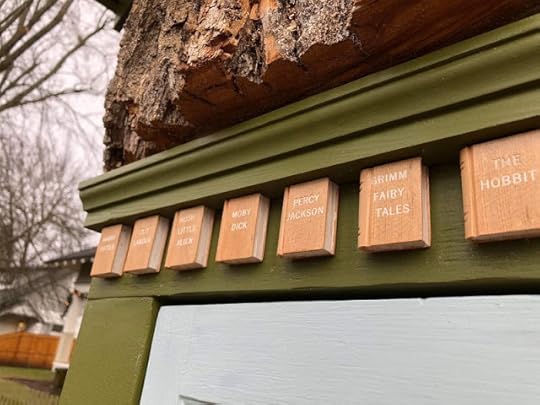
Although the tree needed to come down, likely since her family had bought the house 15 years ago, Howard says that she had a hard time letting go. In November 2018, after a branch dropped onto her son’s car, the end finally arrived. Once Howard saw inside the tree, it was clear that the inner wood had rotted.
But even then, Howard hoped to give the stump another life. “I thought: What if I kept the trunk part of it? What if we make it into one of those Little Free Libraries?” she says. “Immediately I could envision the little steps going up to it. I knew I’d do a lot of features to make it match the house. You just have these ‘what if’ moments and then your brain starts figuring out how to make it work.”

The Little Free Library movement, which was founded in 2009 by the late Todd H. Bol in Wisconsin, was intended to promote literacy and community with the “take a book, share a book” concept. With over 75,000 Little Free Libraries in 88 countries, the idea has taken off, though it’s not without its critics.
Howard, who works for the Coeur d’Alene Public Library, has been interested in Little Free Libraries for a long time, even creating a freestanding one a few years ago as an auction item for her children’s school. Like the tree version, that library included tiny decorative books (she had the school kids select their favorites). “I bid on it until I couldn’t afford it anymore because I really wanted it,” she says.
For her tree library, Howard created an insert—essentially a box—which would fit inside the hole in the stump. That box became the functional part of the library, into which shelving and books were ultimately placed.
Meanwhile, her husband and four children selected the titles for the row of ornamental books. There are classics including Call of the Wild, Nancy Drew, and The Grapes of Wrath, along with contemporary favorites such as Hush Little Alien, Harry Potter, and Percy Jackson. Each faux book was limited to three lines with seven letters per line.

Although she still planned to add some finishing touches, Howard shared her creation on Facebook on December 10, 2018. Local media outlets quickly picked up the story, and over the next month, national publications followed. Since then, Howard’s library has been busy. “There’s been a steady stream of cars,” she says. “There’s literally been people waiting for other people to take their turn.”
Though this is Howard’s best known project, the library is only one of her book- and community-related artistic endeavors.
Years ago, in a quest to create a children’s book to connect far-away relatives, Howard became interested in bookbinding. Unsatisfied with the options available at office supply stores, she began looking into techniques for doing it herself. That passion eventually led to a low-residency degree program in fine binding at the American Academy of Bookbinding in Telluride, Colorado. Currently, she’s binding a copy of Call of the Wild and she’s almost done with Walt Whitman’s Leaves of Grass, which includes grass-shaped insets.
For Howard, the Little Free Library’s purpose is primarily to delight. “Some people think it’s just for kids, but I think adults are just as excited to stumble across a Little Free Library and find something that they want to read. It lets you be a kid,” she says. “It didn’t need to be done. The tree didn’t need to be repurposed, but it’s magic.”
 Clancy's comment: Looks fabulous, eh? Great idea.I'm ...
Clancy's comment: Looks fabulous, eh? Great idea.I'm ...


Published on May 10, 2019 19:01



